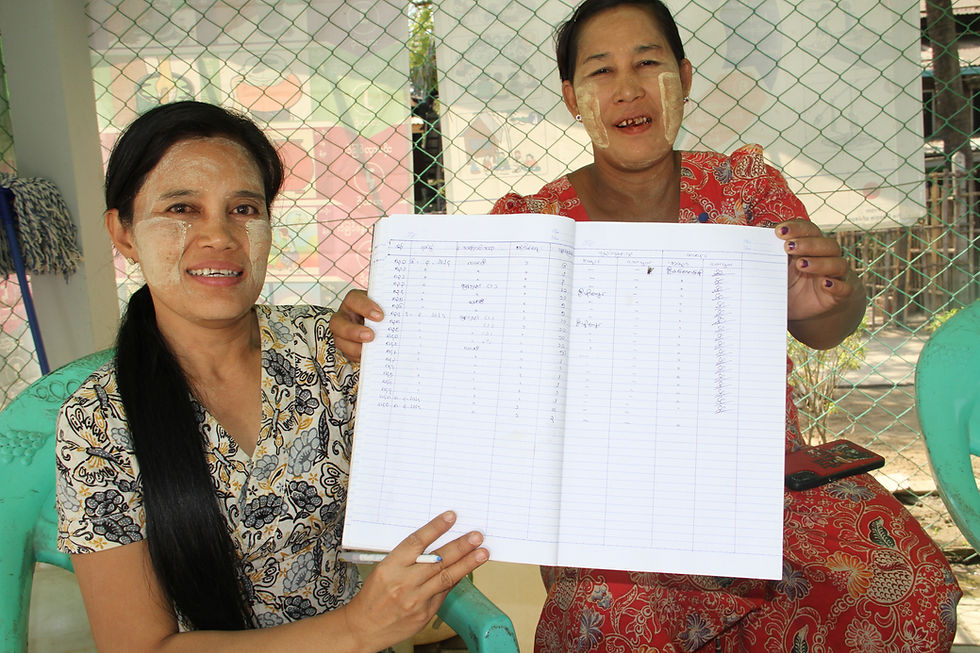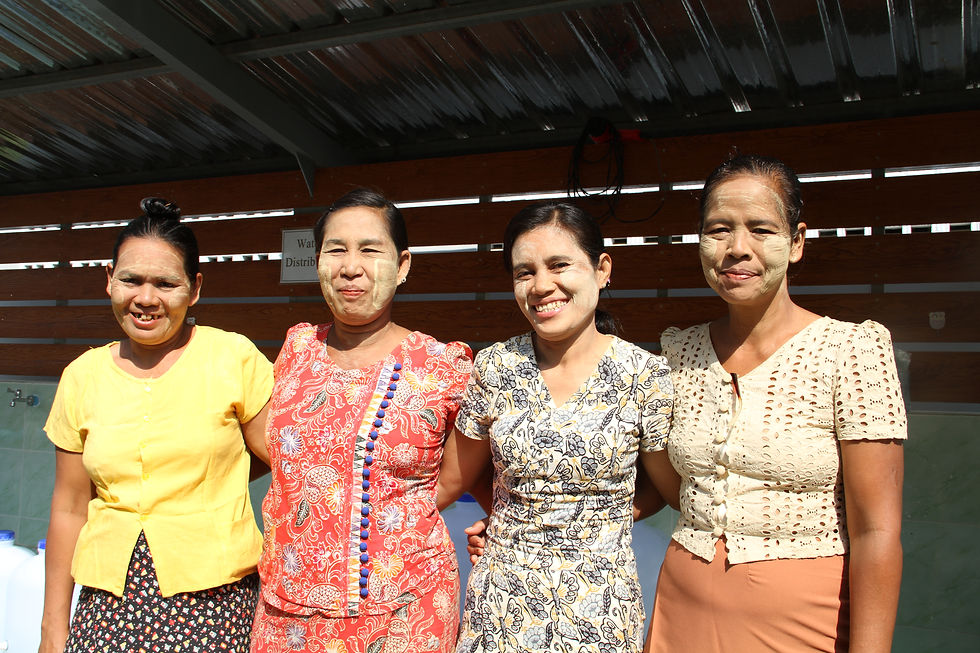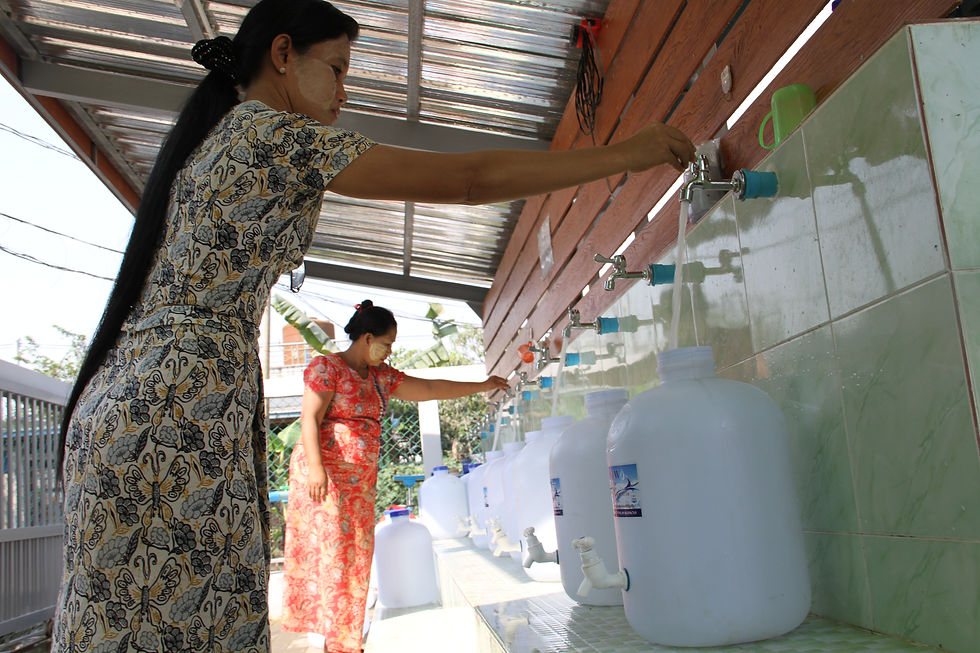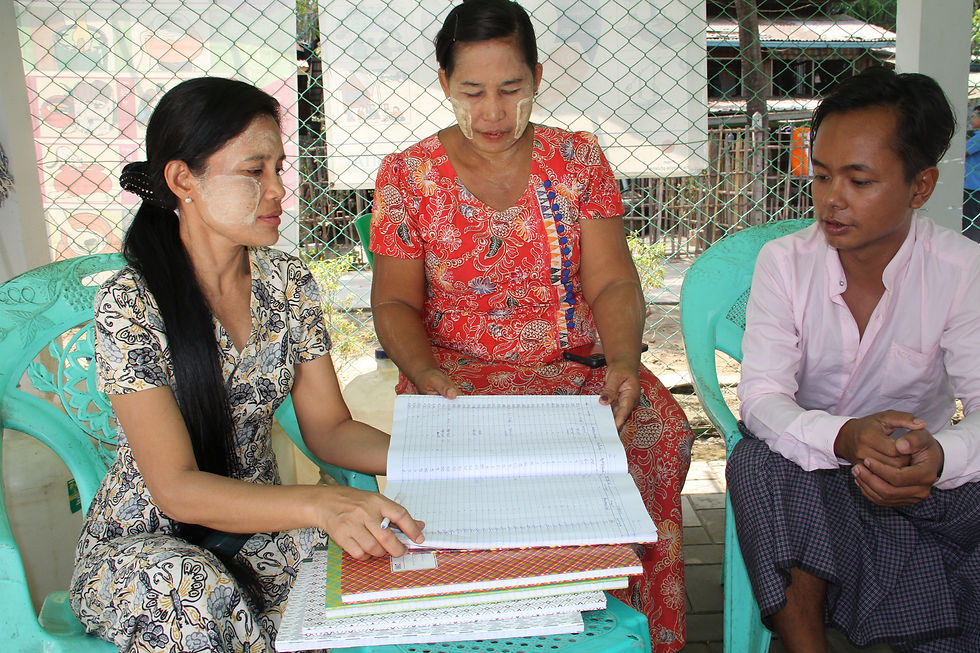
Secretary of the CDC at the stand-alone water treatment plant in Dagon Seikkan Township, showing the inventory and financial record book for transparency.
Myanmar’s forced migration and displacement are driven by escalating political instability, armed conflict, and natural disasters. The situation worsened following the military takeover in 2021, leading to over 3 million people becoming internally displaced as of August 2024, according to the United Nations in Myanmar. The internally displaced persons (IDPs) are primarily located in conflict-affected regions, including Chin, Kayah, Kachin, Kayin, Rakhine, and Shan, states, as well as Magway and Sagaing regions. The military's use of airstrikes and heavy artillery has forced many to flee to makeshift camps, forests, or even neighboring countries to escape persecution and violence.
A poly-crisis of conflict and climate
Under pressure from the State Administration Council (SAC), local officials enforce conscription. Surprise home raids and detentions have generated widespread fear and distrust. Conscription has forced many young people to abandon their education and jobs, intensifying poverty and creating significant economic hardship. This threat has further strained community support systems and negatively impacted young volunteers and workers.
Families living in the informal settlements of Yangon face severe hardships due to rapid and unplanned urban growth, overcrowding, inadequate access to critical services, and increased vulnerability due to ongoing conflict and displacement.
In addition to conflict, natural disasters have further exacerbated Myanmar's forced migration crisis. In April 2024, over 1600 persons died from extreme heat in Myanmar, the majority of them in the Dry Zone, as Chauk town in Magway became the hottest city on Earth. Since late June, heavy monsoon rains and overflowing rivers have inundated several states and regions, worsening an already severe population displacement crisis, and affecting an estimated 393,000 people.
Urban Population Pressure and Water Crisis in Yangon's Informal Settlements
In the bustling city of Yangon, water shortages and pollution are intensifying as people seek refuge from conflict-affected areas. In the city’s informal settlements, where only 6 percent of households have access to piped water, residents have long depended on unreliable and unsafe sources for their daily needs. These informal settlements, often in flood-prone areas, face a distinct challenge. The problem isn’t just the lack of water but the limited availability of safe drinking water. Many residents depend on private vendors, who charge significantly more than public or community-based providers. With rising inflation and stagnant wages, households are increasingly struggling to afford these costs, forcing them to turn to unsafe sources that threaten their health and well-being.

Chairperson of the CDC at the stand-alone water treatment plant in Dagon Seikkan Township, standing in front of the water filtration system.
UN-Habitat’s Initiatives to Strengthen Water Safety and Security in Yangon
In response to these challenges, UN-Habitat launched several initiatives to improve water safety and security in Yangon’s informal settlements. These efforts include a mix of different innovative solutions to address access to water through Community Rainwater Harvesting, new Water Treatment Plants, and the formation of water governance systems in informal settlements through Community Development Committees (CDCs) in each community. These CDCs are composed of local volunteers, including youth and women, who through a social enterprise model, take responsibility for managing and operating the new water supply systems.
Since the 1990s, UN-Habitat has utilized the “People’s Process,” a bottom-up approach that emphasizes collaboration with and empowerment of local communities. This model of locally owned and collaborative development has demonstrated its effectiveness in various challenging contexts, such as post-disaster recovery and upgrading of informal settlements.
Empowering Communities: Building a Sustainable Future Through CDCs
Building infrastructure is just the beginning of a successful water and sanitation program. A major challenge is maintaining these facilities after the project ends. A social enterprise model approach empowers local residents to manage the systems, in the absence of local authorities to support long-term maintenance of infrastructure in informal settlements. The high degree of enthusiasm displayed by the local communities during the design and implementation stages is a good indication of their readiness to embrace change and partake in any efforts that would contribute to the improvement of their living conditions.
UN-Habitat trained CDC members in technical operation and financial management to ensure the systems meet safety standards and remain economically sustainable. This training includes developing affordable pricing structures to cover operational costs, water testing, bookkeeping, and a community water safety plan. As CDCs gain confidence and experience, some are exploring ways to expand their services to local businesses and restaurants.
This capacity-building initiative has had a profound impact on the local communities. Daw Kay Thwe Oo, Secretary of the CDC at the stand-alone water treatment plant in Dagon Seikkan Township, emphasized the importance of transparency and accountability in managing the water system. "To ensure transparency, we record all monthly expenses associated with water production, including electricity, diesel for the generator, and labor costs. The CDC chairperson documents these expenses, which I then review." She also explained the CDC's organization and process for distributing water bottles: "Our CDC consists of seven members—two women and five men—who manage water distribution. We provide water bottles to distributors, who then deliver them to households. We return any surplus bottles after distribution. I keep track of the data on the number of bottles distributed, returned, and remaining balance."

CDC members of a Stand-alone Water Treatment Plant.
By placing CDCs at the heart of the development process, communities move beyond the role of mere beneficiaries to become partners, implementers, and entrepreneurs in the development process. This approach results in an efficient, well-managed program that is more likely to endure long-term and fosters greater ownership and empowerment within the communities.
U Khin Maung Toe, Chairperson of the CDC, provided insight into the water purification process at the Stand-alone Water Treatment Plant. "The water purification process starts by pumping groundwater into a container. From there, the water flows through a series of filters: first an iron (brim) filter, then an activated carbon filter, and finally a steel housing filter," he explained, pointing to the water filtration system. "Following the filtration process, we transfer the water into a clean drinking water container. The final step involves passing the water through a UV lens for sterilization, ensuring it’s safe for consumption."

Daw Kay Thwe Oo, Secretary of the CDC, fills up the water bottles at the stand-alone water treatment plant in Dagon Seikkan Township.
This community-led approach has also resulted in considerable cost savings for residents. "There’s a significant difference between the market price and the cost we provide our water at. While the market price is 700 MMK per bottle, we offer it to the community at a subsidized rate of 300 MMK per bottle," added U Khin Maung Toe.
Participants in the capacity development process can apply their newly acquired expertise to future projects by UN-Habitat or other organizations in their communities, ensuring a lasting impact. Functioning CDCs can also help replicate similar structures in other settlements where residents wish to adopt this model, providing additional benefits to areas with the most pressing needs.
In addition, communal rainwater harvesting solutions provide access to safe drinking water to underserved schools in informal settlements. The project “Building resilience against COVID-19 in urban informal settlements through water, sanitation, and waste management support” brought the innovative Tametotto tank to Myanmar for the first time. This was made possible through a partnership between UN-Habitat and the Japanese company Daiken. The Tametotto underground tank, capable of storing over 150 tons of water, provides a reliable supply throughout the year, including the dry months. A nature-based system filters the collected rainwater, making it safe to drink and reducing the reliance on expensive bottled water or unsustainable groundwater extraction.
In support to improved access to water and sanitation, UN-Habitat also implemented small road segments, household and community latrines, as well as pathways and solar public lights around the water stations. In total, approximately 300,000 persons living in informal settlements in Yangon benefitted from improved access to services and sanitation. For more information on the project and its impact on water safety and security in Myanmar's informal settlements, please visit:

Chairperson and Secretary of the CDC at the stand-alone water treatment plant in Dagon Seikkan Township, checking the record book.

Комментарии